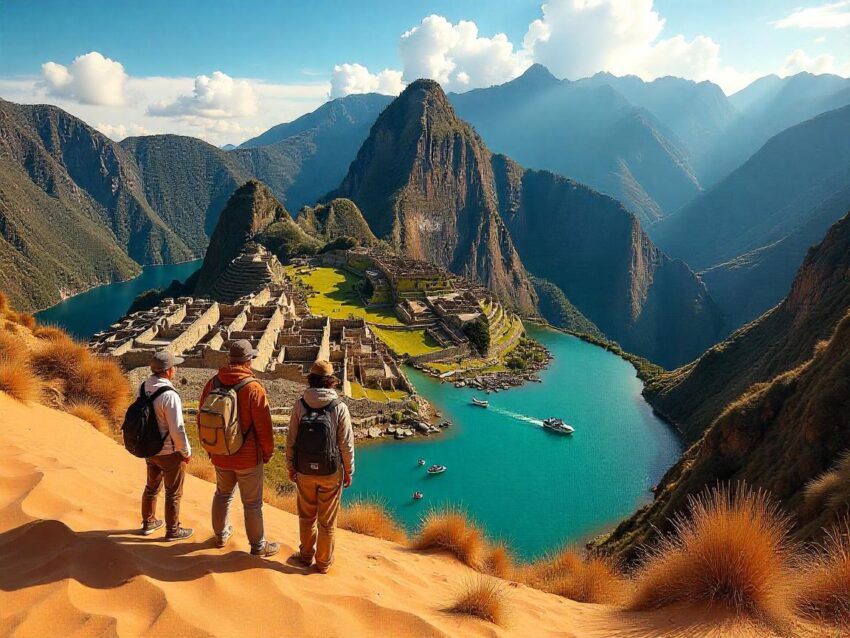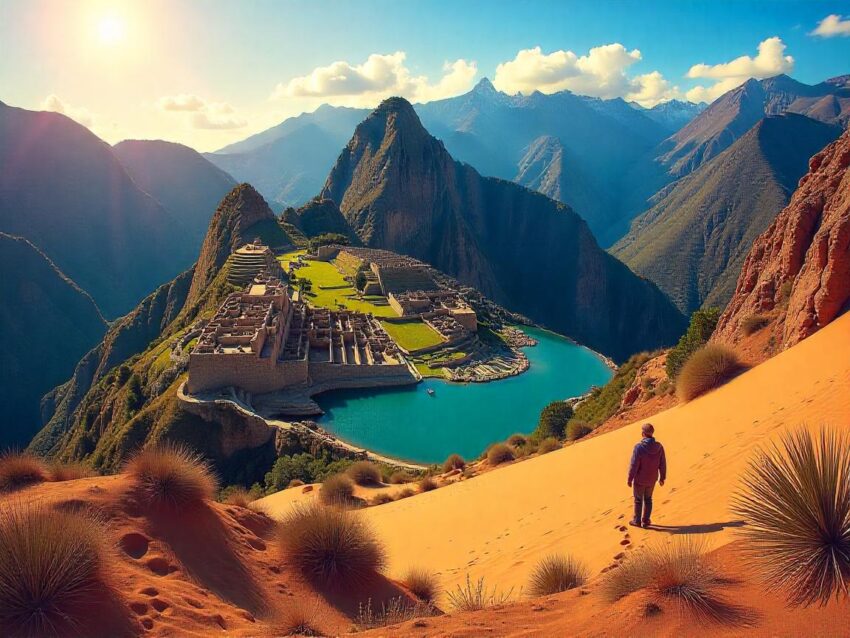Iconic Tourist Attractions in Peru, Huaraz, Lima, Paracas, Huacachina, Nazca, Arequipa, and Machu Picchu Captivate Tourists from US, UK, Canada, Colombia, Ecuador, Brazil, Australia and New Zealand with Inca Civilization, What Will Allure Most

Something extraordinary is happening in Peru. From the snow-draped peaks of Huaraz to the sun-scorched sands of Huacachina, tourists from the US, UK, Canada, Colombia, Ecuador, Brazil, Australia, and New Zealand are arriving in waves, spellbound by the country’s iconic tourist attractions. But what exactly is drawing them in with such force? What is it about Lima, Paracas, Nazca, Arequipa, and Machu Picchu that captivates travelers, ignites imaginations, and leaves hearts pounding?
It’s more than stunning landscapes. It’s the legacy of the Inca civilization—a mystery that continues to breathe life into stone ruins, echo through sacred valleys, and whisper across ancient trails. And yet, that’s only the beginning.
Huaraz stuns with icy peaks that scrape the sky. Trekkers from Canada and the UK come seeking altitude and meaning. Meanwhile, thrill-seekers dive into the shifting dunes of Huacachina, where desert winds carry legends older than time. Why are so many drawn to this desert oasis? Is it the thrill of sandboarding or the surreal silence under starry skies?
In Lima, the journey begins with flavor and flair. The Peruvian capital, once a quick layover, is now a destination in its own right. Tourists from the US and Australia are staying longer, diving into culinary magic and colonial charm. But is this revival of Lima part of a larger travel phenomenon? Or is it something deeper—something spiritual?
Just a few hours away, Paracas invites the curious. Here, the ocean collides with desert in a dance of contrast. Wildlife, winds, and whispers of ancient rituals stir the imagination. Is this why visitors from New Zealand and Brazil are flocking to its windswept shores?
Then come the skies of Nazca. Mysterious lines. Aerial views. Questions no one can answer. Tourists from Ecuador and Colombia gaze down in awe, searching for signs, symbols, truth. What do these ancient drawings mean—and why do they still call out to travelers today?
Arequipa, the White City, lures with elegance and fire. Volcanoes rise. Churches glow. And a quiet kind of wonder unfolds in every plaza. Something in its air feels timeless. But how does it compete with the magnetic pull of Machu Picchu?
Ah yes, Machu Picchu. The crown jewel. The final, unforgettable stop. But will it be the ancient stone citadel that allures the most? Or will Peru’s other secrets rise to steal the spotlight?
One thing’s certain: iconic tourist attractions across Peru, Huaraz, Lima, Paracas, Huacachina, Nazca, Arequipa, and Machu Picchu are not just destinations. They’re gateways. And the world is watching.
This is not just travel. This is revelation. And the story is only beginning.
Peru’s Tourism Reawakens: The Iconic Circuit Drawing Global Travelers Like Never Before
As the world reopens and long-haul travel makes a roaring comeback, Peru has emerged as one of the most magnetic destinations for adventure seekers and cultural wanderers. Tourists from across the UK, Canada, Germany, Spain, Australia, New Zealand, and China are descending in record numbers, tracing the classic circuit from Lima to Machu Picchu—redefining South America’s tourism landscape.
This travel renaissance is not a coincidence. It’s a powerful blend of pent-up wanderlust, strategic destination marketing, improved air connectivity, and irresistible natural and cultural allure. The resurgence is also bringing deep economic revitalization to Peru’s local communities, making each visitor more than a traveler—they’re catalysts of change.
Lima Sets the Stage for Exploration
Lima, Peru’s bustling capital, is no longer a fly-through city. British Airways and LATAM have increased direct flight frequencies from London and Toronto, while new bilateral agreements are easing travel for Australian and New Zealand passport holders. The city’s culinary scene, coastal charm, and historic districts are compelling tourists to linger longer.
Major hotel chains, such as Marriott and Accor, are expanding their Lima footprint. Boutique hotels in Miraflores and Barranco are seeing 70–85% occupancy rates—up 40% year-over-year.
Huaraz Emerges as a High-Altitude Haven
Adventurous travelers from Germany and Canada are turning their eyes toward Huaraz. Tucked in the Andes, this alpine town is booming as a gateway to the Cordillera Blanca. Trekking demand has surged by 55%, with the Santa Cruz and Laguna 69 trails leading the way.
Sustainable tour operators are capitalizing on eco-conscious travelers from Europe and Oceania. Meanwhile, the Peruvian government is investing in rural airstrips and road infrastructure to facilitate easier access and safer travel.
Paracas and the Rise of Coastal Ecotourism
Paracas is experiencing a quiet revolution. Once a sleepy coastal town, it’s now the heart of Peru’s burgeoning ecotourism trend. Chinese and Spanish visitors are particularly drawn to the Ballestas Islands and the Paracas National Reserve. Travel agencies report a 38% increase in demand for marine biodiversity tours.
The luxury segment is thriving too. Resort expansions by brands like Libertador Hotels are drawing high-end travelers seeking nature without sacrificing comfort.
Huacachina and the Desert’s New Gold Rush
The oasis town of Huacachina, once a hidden Instagram gem, is now a headline destination. Australian and Canadian tourists are driving a boom in sandboarding, dune buggy adventures, and overnight desert camping.
However, with popularity comes pressure. Local authorities have implemented strict visitor caps and dune preservation policies to combat environmental degradation. The town’s sustainability push has become a model for other high-traffic tourist zones.
Nazca Lines: Ancient Mysteries, Modern Magnetism
Demand for aerial tours over the Nazca Lines has reached its highest in a decade. Chinese and German tourists are particularly fascinated by these UNESCO-listed geoglyphs. Aviation companies are expanding their fleets to meet the surge, even as they navigate new safety and environmental regulations.
Meanwhile, Nazca’s cultural tourism scene is diversifying. Workshops, archaeological experiences, and museum expansions are helping lengthen visitor stays beyond the iconic flyovers.
Arequipa: The White City Rises
Arequipa has shed its “second city” label. Its dramatic colonial architecture and the looming El Misti volcano have caught the eye of digital nomads and long-term travelers. New co-working hotels and digital visa pathways are luring remote workers from Spain and Australia.
The city’s improved airport connectivity and luxury bus networks have positioned it as a convenient—and increasingly indispensable—stop along the southern travel corridor.
Puno and Lake Titicaca: Spiritual Serenity in High Demand
Lake Titicaca has become a soul-searching retreat for many post-pandemic travelers. Canadians and New Zealanders are especially drawn to its mystical landscapes and indigenous traditions.
Tour operators are integrating immersive, community-based experiences, giving travelers a deeper connection to local Aymara and Quechua cultures. Floating island stays on Uros are now fully booked months in advance, pushing local authorities to expand responsible tourism options.
Cusco: Peru’s Cultural Capital Gets Smarter
Cusco remains the heartbeat of Peruvian tourism. However, the city is embracing smart tourism strategies to handle the influx. Real-time data monitoring, crowd control systems, and mobile visitor apps are transforming how travelers experience the ancient Inca capital.
Hotel investments are spiking. New boutique hotels aimed at luxury backpackers and middle-tier explorers have opened across San Blas and the Sacred Valley, directly responding to growing interest from UK and German tourists.
Machu Picchu: Managing the Magnetism
Machu Picchu remains the crown jewel, but managing its magnetism is the challenge. New electronic ticketing systems, staggered entrance times, and rail service upgrades are in place to manage peak-season crowds—especially those arriving from China and Europe.
UNESCO compliance is a driving force. Local authorities are now enforcing strict visitation limits, while also promoting lesser-known alternatives like Choquequirao and Huchuy Qosqo to relieve pressure on the iconic citadel.

Peru Reignites Wanderlust: A Global Surge in Tourists from the U.S., UK, Canada, Germany, Spain, China, and Beyond Fuels a Travel Revival Like No Other
As borders reopen and the rhythm of global travel returns with newfound energy, one country is stealing the spotlight—and the hearts—of millions: Peru. From the mystical ruins of Machu Picchu to the crystalline waters of Lake Titicaca, this Andean gem is witnessing a travel boom unlike anything seen in the past decade. It’s not just a surge. It’s a movement. A rekindling of global wanderlust.
Tourists from every corner of the world—the United States, United Kingdom, Canada, Germany, Spain, Australia, New Zealand, and China—are packing their bags and pointing their compass toward Peru. For some, it’s a long-awaited dream. For others, it’s a newfound curiosity sparked by viral images and epic stories. But for all, it’s a journey that promises more than beauty—it delivers transformation.
After years of pandemic-induced travel suppression, the global appetite for immersive experiences has returned stronger, bolder, and more intentional. People are no longer just booking vacations. They’re chasing purpose. And Peru, with its kaleidoscope of culture, altitude, flavor, and soul, offers that purpose in spades.
| Country | Airlines Operating Direct Flights to Peru |
|---|---|
| United States | American Airlines (MIA–LIM), Delta Air Lines (ATL–LIM), JetBlue Airways (FLL–LIM), United Airlines (IAH & EWR–LIM), LATAM Airlines (JFK–LIM) |
| United Kingdom | LATAM Airlines (LHR–LIM) – 5 weekly flights using Boeing 787-9 |
| Canada | Air Canada (YYZ & YUL–LIM), Air Transat (YYZ–LIM), United Airlines (YYZ–LIM) |
| Colombia | Avianca (BOG–LIM), LATAM Airlines (BOG–LIM), Wingo (BOG–LIM), JetSMART (BOG–LIM) |
| Ecuador | LATAM Airlines (UIO–LIM), JetSMART (UIO–LIM), Avianca (UIO–LIM) |
| Brazil | LATAM Airlines (GRU, FLN–LIM), Sky Airline (GRU–LIM) |
| Australia | LATAM Airlines (SYD–LIM via AKL or SCL), Qantas (SYD–LIM via SCL), United Airlines (SYD–LIM via LAX) |
| New Zealand | LATAM Airlines (AKL–LIM via SCL), Air New Zealand (AKL–LIM via SCL), Qantas (AKL–LIM via SYD) |
A Tapestry of Journeys: Where the World Meets Peru
Each traveler brings with them a unique motivation. Americans flock to Peru for its ancient wonders, spiritual energy, and striking biodiversity—from Lima’s culinary brilliance to the Amazon rainforest’s pulsing life. British and Canadian explorers are drawn by iconic trails and colonial architecture, carving out itineraries that blend adrenaline with reflection. German and Spanish tourists seek depth, diving into archaeological sites and indigenous heritage that echo thousands of years of history.
Chinese travelers, one of the most rapidly growing segments, are venturing into Peru with intense curiosity. For many, it’s a bridge between two ancient civilizations—an opportunity to walk amid Inca ruins while contemplating the mysteries of their own dynastic past.
Australians and New Zealanders, seasoned in long-haul travel, are planning extended, multi-stop adventures across Peru’s rugged terrain, often combining cultural immersion with outdoor exploration. For these travelers, the journey is not just about sightseeing—it’s about reconnection with nature, with history, and with themselves.
From Lima’s Coast to the Peaks of the Andes
This influx of global visitors follows a familiar but ever-evolving route—a circuit that stitches together Peru’s most breathtaking destinations in a single narrative of awe.
It begins in Lima, where culinary delights and coastal winds greet travelers with an energetic welcome. No longer a mere stopover, Lima has become a gourmet hub and historical treasure chest. Here, the Pacific Ocean meets colonial cathedrals, and high-end restaurants now rival Europe’s best.
From Lima, tourists spread out toward the Andes and the jungle. In Huaraz, high-altitude seekers from Germany and Canada lace up their boots for adventures into the Cordillera Blanca. These mountain escapes are not just physically rewarding—they’re emotionally clarifying.
Down the coast, Paracas and Huacachina appeal to those chasing the unusual: desert oases, marine life, and surreal sand dunes. The silence of Huacachina’s golden waves at sunset is an experience that stays with you—etched in memory, not just in photos.
Further south, travelers take to the skies over Nazca, tracing the enigmatic lines etched by ancient hands. Here, Chinese and European visitors marvel at the aerial spectacle, trying to unlock secrets left behind centuries ago.
In Arequipa, the White City’s baroque architecture and volcanic backdrop provide a slower, reflective pace. Digital nomads and slow travelers from Spain and Australia linger here longer, weaving work with discovery.
Then comes Puno, where the highest navigable lake on Earth—Lake Titicaca—calls out to seekers of serenity and spiritual depth. Floating islands, indigenous communities, and golden sunsets make this destination a standout for those craving cultural authenticity.
And finally, Cusco and Machu Picchu—the crown jewels. No image, no article, no story truly prepares travelers for the first moment they lay eyes on the Inca citadel nestled among the clouds. It’s an emotional summit, the climax of a once-in-a-lifetime pilgrimage that ties every step together.
A Global Travel Reawakening—And Peru Is at the Heart
This resurgence isn’t just a statistical rebound. It’s a global emotional response. People are traveling again not for luxury, but for life. And in Peru, they find life in every glance, every bite, every sunrise over the Andes.
Tour operators report record bookings. Airlines are scrambling to add more flights from Europe, North America, and Asia. Hotel chains and boutique lodges alike are racing to expand capacity. Peru’s tourism economy is not just recovering—it’s being reimagined.
The destinations may be ancient, but the momentum is entirely modern. Fueled by data, digital marketing, and social storytelling, Peru’s allure is touching hearts across the globe. From Toronto to Berlin, from Beijing to Sydney, travelers are choosing Peru not just because it’s beautiful—but because it means something.
Because after everything the world has been through, travelers aren’t just chasing places. They’re chasing purpose. And Peru delivers it with every step.
Market Impact and Outlook
The ripple effect is clear. Peru’s tourism revenue has climbed by 62% year-on-year in Q1 2025. Flight bookings from Canada and the UK are up 45% compared to the same period last year. Spain and Germany follow closely, while outbound Chinese travel has nearly returned to pre-pandemic levels, with Peru listed as a top-five destination.
Tourism stakeholders expect the full circuit—from Lima to Machu Picchu—to hit capacity by late 2025. Hotel chains are racing to expand capacity. Airlines are lobbying for more landing slots. Infrastructure upgrades are underway.
The urgency is palpable. The opportunity is now.
Final Thought: More Than a Trip—A Transformation
For millions of global travelers, Peru is no longer just a bucket-list destination. It’s a profound journey into history, heart, and humanity. The emotional resonance of standing in the Sacred Valley, or tracing ancient paths under Andean skies, is rewriting what meaningful travel looks like.
And for Peru, this influx isn’t just tourism. It’s transformation. A nation reconnecting with the world, one visitor at a time.
The post Iconic Tourist Attractions in Peru, Huaraz, Lima, Paracas, Huacachina, Nazca, Arequipa, and Machu Picchu Captivate Tourists from US, UK, Canada, Colombia, Ecuador, Brazil, Australia and New Zealand with Inca Civilization, What Will Allure Most appeared first on Travel And Tour World.
Iconic Tourist Attractions in Peru, Huaraz, Lima, Paracas, Huacachina, Nazca, Arequipa, and Machu Picchu Captivate Tourists from US, UK, Canada, Colombia, Ecuador, Brazil, Australia and New Zealand with Inca Civilization, What Will Allure Most
| Divisions of Shy Paris Entertainment | ||||
|---|---|---|---|---|
| Shyparis Entertainment | Shy Paris Bookings | Linkz Radio | Klublinks | Shy Paris |
Shy Paris Bookings is a Division of
❤Shy Paris Entertainment ||||| International Spectacular Events, Stellar Event Planning and Management, & Celebrity Booking Agency. Please contact us as we can provide you with both international and/or local renowned full service event planning and management, & celebrity bookings at shyparisentertainment@gmail.com or
CONTACT: Email: shyparisentertainment@gmail.com
Facebook: ShyParis Youtube: @Shyparis Twitter: @Shyparisent Instagram: shyparisentertainment Whatsapp: 1-437-259-3399
✶✶✶✶✶✶✶✶✶✶✶✶✶✶✶✶✶✶✶✶✶✶✶✶✶✶✶✶✶✶✶✶✶✶✶✶✶✶✶✶✶✶✶✶✶✶✶✶✶✶
SHY PARIS ENTERTAINMENT COMPANIES
✅ ShyParisentertainment.co – https://shyparisentertainment.co
✅ Shyparisbookings.com – https://shyparisbookings.com
✅ Linkzradio.com – https://linkzradio.com
✅ Klublinks.com – https://klublinks.com
✅ Shypariswebdesign.com – https://shypariswebdesign.com
✅ ❤️ Shyparis – htttps://shyparis.com❤️

